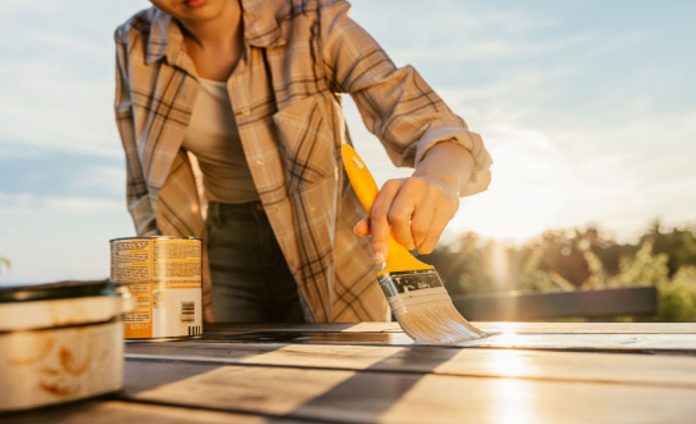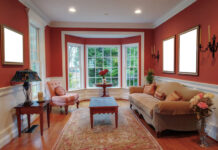A foolproof way to lighten your house’s interior or exterior is to take on a painting project. Nothing brings out the freshness of a room as a new lick of paint. Moreover, a new paint job can be a lot of fun. It is a simple and fast yet transformative and flattering change. You can consider painting it yourself, but it can be a hassle. The most significant benefit of DIY painting is cost savings, valid for only small paint jobs. However, painting an entire house is not practical. A long list of supplies, including drop cloths, rollers, trays, and brushes, will cost you a fortune for a one-time painting gig. Thus, your best bet is to hire professional painters from a reputable painting company or independent painting contractors.
In this case, you should estimate an average painting cost for a small room. Of course, room size will change hence the cost to paint as well, but it will give you a reliable estimate of your total cost.
Nonetheless, there are variables. Interior painting costs are different from those of outdoor areas. Additionally, room size, wall space, and condition are significant factors. For instance, if the paint job requires a stain-blocking primer, undercoat, or topcoat, plaster the price changes accordingly. Last but not least, paint quality changes the paint job’s cost.
Comparing Quotes Could Save You Upto 33%:
Painting and Decorating Price List
The following table provides a comprehensive pricing list for typical examples. Moreover, the cost is for interior painting projects. If your home’s interior doesn’t have the exact measurements, you can compare the given dimensions with those of your property. Hence, you can approximate your home’s interior painting and decorating cost.
| House Size | Duration | Cost |
| One bedroom flat paint | 1-2 days | ₤700 |
| Two bedrooms flat paint | 2 days | ₤1000 |
| Three-bedroom house | 2-3 days | ₤1100 |
| Four bedrooms semi-detached house | 2-3 days | ₤1200 |
| Five bedrooms detached house | 4 days | ₤1300 |
The painting costs shown here are approximated but are very close to the actual project costs. The painter and decorator’s day rates suit most of the country; however, a painting company in London and a little towards the southeast of England will charge 10-20% more.
Let’s break down the painting costs into sub-factors. Around 80% of the quote is for labour costs, and the remaining 20% accommodates the materials costs. Some interior painters charge an extra 20% that covers travel costs and miscellaneous payments.
Comparing Quotes Could Save You Upto 33%:
These costs may seem intimidating, but a professional painter is skilled in preparing walls and woodwork; hence, their experience and technique will give your entire interior painting project an excellent finish. By comparing quotes from different local painters and painting contractors, you can save money and get a bang for your buck.
Painting Woodwork
The cost to paint given in the table considers emulsion paints on interior walls and ceilings. However, a painting contractor can do much more—for instance, woodwork like windows, doors, stairs, skirting boards, etc. Generally, painters do not charge extra labour costs for woodwork paintings and only add the paint cost in the final amount when giving you the average cost to paint your room.
You may think that woodwork painting is not essential; however, that’s not the case. When all the walls in the room have fresh paint, the woodwork will look extra old and shabby. Thus, you should invest in woodwork painting so that the bedroom walls not only look new, but the entire interior shines.
Comparing Quotes Could Save You Upto 33%:
Is a Small Room Size Easier to Paint than a Larger One?
You are mostly right if you think painting a small room is more straightforward than painting a larger one. However, if the small room has less floor space, more corners, and awkward shapes, that’s a different story. In such cases, you can expect the paint job to take more time than painting the flat surface of a standard rectangular room.
Moreover, you may have noticed that bathrooms and kitchens take longer to paint than bedrooms. Although bathrooms are usually smaller than most rooms, the small wall and floor space make painting difficult and time-consuming. Similarly, kitchens have base units and cabinets, which leave a small window for painting.
Let’s dig deeper into the average cost per square foot for different paint jobs, including woodwork, primer, and oil paints.
Small Rooms
The average price to paint a small room with a wall space of around 15m2 will be about ₤200-₤300. This cost usually includes prep work and two coats of emulsion on the interior walls and ceilings. Moreover, the total cost consists of preparing an undercoat and topcoat (semi-gloss or high gloss paint) for woodwork.
If you use higher quality paints, the average will be towards the upper end of the range and vice versa for a cheaper painting job.
Medium Rooms
The average cost to paint a medium room size with a wall space of 30m2 is around ₤400-₤600. Once again, this includes preparation for walls, woodwork, and ceiling with two coats of emulsion paint.
Large Rooms
If you have a larger room with a wall space greater than 60m2, the painting costs for surface preparations, emulsion paint coats on the walls, ceilings, and woodwork will cost around ₤800-₤1200.
Please note that all the costs we have calculated include average labour costs.
Stairs
A painting project that includes stairs can be a bit tricky. They are different from the other parts of your house, and measuring the area in square feet is hard. Stairwells have high walls, so the painter will use scaffolds to reach the ceiling. Hence, the average labour cost and material costs for your interior painting project will rise.
The type of staircase will also determine painting costs. For instance, additional sanding is needed before applying primers if the stairs are made of hardwood. This will naturally increase materials costs for your project.
Other Jobs
Painters and decorators are not only good at painting walls and woodwork. The most common type of job, other than painting, is installing wallpaper in different sizes and textures. Some are better suited for plain textured walls, while others may be better for safety reasons (to improve the strength of underlying plaster).
In either case, hanging a wallpaper requires skill, especially for accent walls with different textures and shapes. Wallpaper adds a more visually-pleasing look to your room, but it will surely boost the average cost to paint.
Inside Jobs
Many minor and major tasks might assist a decorator or interior painter with the actual interior painting, such as:
- remove/replace curtain poles and tracks
- adding plaster in a room at corners between walls and ceilings
- adding ceramic tiles to bathrooms and kitchen
- adding a bead of mastic around external doors to prevent water leakage into the house interior
- replastering old and shabby areas of the walls before painting
- repairing woodwork damage before painting
- refitting carpets after painting (although its best to leave carpet fitting to respective professionals)
- choose interior paint colours that compliment your main bedroom or other specific areas.
- Touching up scrapes and scratches in paint after installing carpets or furniture
The little things make all the difference. Hence, consider hiring a decorator instead of a painter if you want your interior paint to scream perfection. The average cost may increase, but it is worthwhile.
Outside Jobs
Other than uplifting the interior vibe, decorators can also do some outdoor tasks, such as:
- Painting outdoor structures like walls, windows, renderings, sheds, etc.
- treating damp areas before painting
- treating sheds and fencing panels with garden wood preservatives
- repairing minor damage like cracks in outside walls
Comparing Quotes Could Save You Upto 33%:
Types of Paint Finishes
Interior paints come in many types, and usually, you can use anyone for your home interior. Nonetheless, the price will vary depending on how much paint you use and the print quality.
-
Water-Based Emulsions
Emulsions are the most commonly used paints and are suitable for big jobs like apartment painting or the main bedroom. Moreover, they are great for cement, plasters, and masonry surfaces. They have a water solvent, making them perfect for a cheaper painting job.
There are two major categories of emulsions: vinyl matte and vinyl silk.
-
- Vinyl content makes the paint waterproof, durable, and easy to maintain.
- The matte version gives a flat finish with no shine.
- The silk version has a semi-gloss finish.
-
Oil-Based Paint
These paints are perfect for woodwork. This is a good-quality paint but requires some prep work. The wood needs a fresh coating of stain-blocking primer, which absorbs into the wood. Later a protective undercoat is applied, and the top coat is the oil paint. The shiny finish of these paints will uplift the overall look of your entire home interior.
-
Matte Finishes
Matte finish is commonly known as flat paint. The surface is not shiny and doesn’t reflect light. The best quality paint will have 0% shine, while some low-quality ones may give a 10% glossy finish.
We won’t recommend this paint for your whole house interior, as they are challenging to clean and maintain.
-
Semi-Gloss
Such paints are great for outdoor areas, bathrooms, and kitchens with moisture in the air. They resist grease and are easy to clean.
-
Gloss
Many people do not like the gleaming finish of gloss paint, but they are the easiest to clean and maintain. However, the gleaming finish will also highlight imperfections; hence, it’s not a good option for textured walls.
-
Eggshell paint
Some people use satin paint for eggshell paint; both are similar. This paint gives a lustrous finish rather than a matte look and isn’t shiny. Rooms with high traffic, kids, and high moisture exposure use such paints.
Comparing Quotes Could Save You Upto 33%:
Variations in Cost to Paint
The paint cost depends on several factors, including manufacturer, type, coverage area, and surface type.
We recommend you consult a specialist and use the brand they recommend instead of the cheaper option. High-quality paint covers less area, but on the other hand, low-quality paint will need multiple coats. Thus you may end up paying twice the price for choosing substandard paint. For instance, an emulsion paint costs ₤8-₤18 per liter, while an oil-based paint costs ₤30 per liter. However, you use less oil paint than emulsion paint, which will balance the overall painting cost.
The type of painting project also affects the painting cost. If you hire interior designers to create an accent wall for your home, you should expect the average price for the job to increase by 20-30% for the extra paint. Accent walls have more contour and texture, so both labour and material costs will spike.
How To Apply Paint?
Many people who aren’t professional painters ask this question. The answer is simple, to paint interior walls, you need to follow two simple rules.
Firstly, paint from top to bottom. Start at the ceiling and apply thin layers of paint just enough to cover the base. A thick and uneven layer will cause the paint to drip, giving an unpleasant look to the walls. Sometimes, you may need to re-paint interior walls, increasing the average cost to paint an interior wall. You can always hire a local interior painter if this seems like a hassle.
Secondly, paint the walls first and then the skirting. By doing so, you can be a little messy without worry. Later, paint over the skirting carefully and cut with straight vertical lines. Again, professionals are more skilled, so consider spending on interior painters and listen to their suggestions. They know more about interior paint than you do, so trust them!
To paint inside the house is much easier than outside. Hence, for interior painting, you can experiment yourself, but for outdoors, we recommend you hire a professional painter. To find the best professional painter in your locality, try Bark services. They provide comparative quotes so you can choose a painter with a reasonable final cost. Moreover, the quotes are very reliable and close to actual project costs.
Comparing Quotes Could Save You Upto 33%:
Common Interior Painting Cost Quotation Factors
Always ask your contractor to provide quotes for your painting jobs. In this way, both parties know where they stand. You can also use platforms like Bark to find the best painting and decorating services in your area with a detailed quote on the cost of exterior or interior painting. You can mention every detail of your project (textured walls, accent walls, the area in square feet, etc.) for a precise quote.
Nonetheless, a few loopholes make estimating final interior painting costs difficult.
-
Rotten Wood
Rotten wood is more common than you may think. While painting contractors remove the top hard layer of previous paint, they may find rotten wood under that shell. This is not a complex problem for a professional painter; however, you should discuss how to handle unexpected situations like this with your painter before signing the contract.
The best thing to do is to set hourly charges for any extra work that isn’t discussed in the quote. This way, the painter will tell you how much paint, prep work, and time is needed to sort things out. You can then calculate the extra charge according to the agreed hourly rate. This is very convenient for apartment painting, as you do not know about the condition of the place.
-
Bad Plaster
When removing wallpaper, you do not know the condition of the underlying wall. Most people use wallpapers to cover up wall damage, so a bad underlying plaster is also very common. The painter can sometimes repair it with filler, but you will need to hire a plasterer for severe damage. If the painter can fix it, he will charge you extra as it increases the prep work for painting. Nonetheless, this is worthwhile in the long run because paint covers more area for a smooth wall.
The solution to a terrible plaster problem is setting an hourly rate for unexpected extra work.
-
Removing Wallpaper
One way to reduce overall printing costs is to remove the wallpaper yourself. You can be more involved in your home interior and save labour costs by doing the work yourself. However, consult your painter about how much work you should do and what should be left for the professionals. The painter will let you know how much paint you need by looking at the condition of the underlying plaster, so removing the wallpaper yourself can be an excellent way to save money.
-
Behind Radiators
Sometimes, you may need to remove room radiators for a smooth finish, especially for an accent wall. A painter can do so; however, if the radiator is in bad shape and very old, you will need the assistance of a plumber or extra labour. Once again, your interior painting costs will rise because the plumber or interior painter will charge for the extra work.
-
Tobacco Smoke
If someone in your house is a heavy smoker, you might have nicotine stains on the walls and ceilings. The painting cost will rise in such cases as you need a good primer to cover up the stains. If you directly apply emulsion paint on stains, it won’t stick. Your painter should tell you about the different primers and include them in the quote. However, if he doesn’t, you should ask yourself if your interior painter is skilled enough.
What to Ask Your Painter or Decorator?
When you hire a painter or decorator, you should do some prep work and research their skills and experience. The best way is to ask many questions. Here are a few things you should ask a painter before hiring them.
- Find out if the quote includes VAT. Many contractors provide quotes without VAT, so do ask beforehand.
- Make sure the painter visits the job site before giving a quote. A quote on the phone is unreliable as the painter does not know the exact nature of the work.
- Make sure you know the brand of paint they use so you can judge if the average cost to paint is accurate.
- Decide a payment method early on. If the painter wants cash, get a written receipt on the company’s official letterhead. Moreover, never pay the total amount upfront.
- Painters are exposed to chemical solvents while painting which can lead to health problems. Reputable painters will have professional training and personal protective equipment, prioritizing safety and protocol.
- Reputable painters may hold other qualifications like City and Guilds Painting and Decorating NVQ qualifications.
- Most professional tradespeople are part of The Guild of Master Craftsmen.
- A painting company affiliated with The Painting and Decorating Association is credible, as it is the most prominent painter’s association in the UK.
You can save yourself the trouble by using expert opinions from Bark. They search for painters in your area, do the research, provide shortlisted recommendations and give extensive quotes per square foot.
Comparing Quotes Could Save You Upto 33%:
FAQs About Interior Painting & Decorating
1. What is the difference between professional painters and decorators?
The terms are interchangeable, but in principle, they have different meanings. Interior Painters are professionals in applying paints, stains, and varnishes. A decorator has a greater skill set and can combine colours, work with wallpapers and create an overall theme for your room. Thus, consider hiring a decorator instead of a painter if you want a custom accent wall.
2. Can I paint over an old paint job?
This depends on the condition of the old paint. If the new interior paint is chemically the same as the old one, you can paint over it. However, if you are switching paint types or the underlying paint colour is very different from the new one, you may need to apply a cheap undercoat of similar colour or remove the old paint. Please note that if you remove the old paint or use a grey undercoat, the interior painting cost will shoot up.
3. What is the quickest way to paint a room?
There is no set standard for painting; however, you can follow the given sequence that works in most cases.
- Prepare surfaces by sanding, filling holes and cracks, removing dirt and stains, etc.
- Always paint the ceiling first as it is the warmest part of the room and dries immediately, so you can start painting the walls without delay. Make sure to use a roller and cut in at the edges with a brush for an even look.
- Go in layers. Cut and roll the first coat, let it dry and then apply the second coat. Patience is key here.
- Paint undercoats on woodwork while overlapping the painted edges.
- Cut and roll the second emulsion coating while the first one dries.
- Apply glass coat to woodwork. Cut in gloss paints carefully without any overlap on the wall edges.
- Keep the windows open and exhausts switched on for ventilation during the entire time. In case of dust coming in due to windy weather, close the windows but keep the exhaust turned on.
An alternate way to paint a room is to hire a professional. You can either put in the hours and labour or skip all that by paying an experienced painter or decorator to do the job for you.
4. What is the correct order to carry out an interior painting project?
In most cases, you should paint the ceiling first, then the walls from top to bottom, followed by the skirting. The very last job should be the woodwork. The sequence works in most cases, but some house interior requires a different approach, and a professional painter can make the right call.
5. What kind of pre-work do I need to do?
To save money, you can do some prep work yourself. Place drop cloths on the floor and wash the woodwork and walls to remove stains, grease, or any other residue. If you apply a filler, wait for it to dry completely before applying a base coat. Additionally, make sure all the surfaces are smooth and dry before painting. Sometimes you may need to vacuum the dust away for a flawless final look.
6. What makes a good professional painter and decorator?
A good painter and decorator is a professional with ample field experience. The critical point for a veteran is being able to paint inside your house without a hitch and tackle unexpected situations.
Most importantly, a painter with a high interior painting cost isn’t always the best. You should ask questions and check reviews before handing off your house painting to them.
7. Do you have to sand before starting any painting project?
Usually, yes. Sanding helps to make the surface extra smooth and fills any cracks and holes. After sanding, vacuum the dust and wipe the surface with a wet cloth to remove all sanding residue. You can significantly reduce the paint cost by making the surface smooth and clean with sanding.
Find Local Painters and Decorators near you.
Painting your home is a one-time thing. Thus, make sure that you are working with reliable people. However, it is easier said than done. With so many people claiming to be the best, it is hard to pick the real from the fake.
To make your life easier, there are platforms like Bark, which do the job for you. Using their services, you can get the best recommendations from local painters and choose the right one fast with little effort. Additionally, you can get multiple quotes on your property per square foot to decide how much you will be spending on the paintwork. Overall, the more you know about the painters and the basics of painting, you can take control of your project and avoid scams.
Comparing Quotes Could Save You Upto 33%:
Disclaimer: This article contains sponsored marketing content. It is intended for promotional purposes and should not be considered as an endorsement or recommendation by our website. Readers are encouraged to conduct their own research and exercise their own judgment before making any decisions based on the information provided in this article.



































